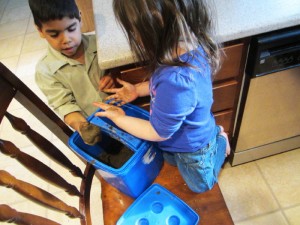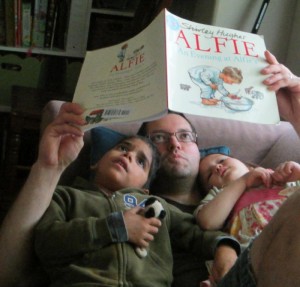Two fillets of cold cooked salmon are in front of me. A bowl of cold mashed potatoes and a few eggs are waiting to join the party. Most of us are finishing school for the day and I’m prepping dinner, fielding questions about fish from one child and questions about subtraction from another.
I’m flaking apart the salmon, pulling out tiny elusive bones. There’s a little pile of them on the counter.
Cham is next to me, supervising. “What are you doing? What is that? Why are you doing it that way?” She’s four…as if you couldn’t tell.
“Are dose the fishes bones? What are you gonna do wif ‘em?” My sleeve starts to slip down, and both of my hands are a mess. I swipe my arm against my hip to pull it back up.
Her sister is having woes with a math problem at the table. “Mom, can you look at this?” And I look…across the room at her, and then the project in front of me, and back at her.
My eyebrows are clearly saying, Are you serious? but my voice is saying, “Maybe if you bring it here…”
I mix in the mashed potatoes and some flour, and explain how to borrow from 6000 to subtract 4536. Throw in a few eggs.
This is no job for a spatula, and my hands go right in, mixing everything together.
The peanut gallery is still watching me, swinging her feet from the barstool.
“Your hands are slimy.” She’s right. Gelatinous goo from cold fish oil is almost up to my elbows and I pull my sleeve back up with my teeth.
She slides off the barstool and goes to a cabinet. “Are you gonna use dis?”
“Nope, we don’t put cocoa in salmon patties.”
Another cabinet. “Do you want the big pot?”
“Nope, I’m going to use this pan. Thanks, though.” Cutie.
But it’s time. Mama needs a break from it so we can get some work done.
“Watch out!” I wave my slime-covered hands at her. “I’ll get you!” She shrieks and leaves…for a few minutes, at least.
She wants to help and it’s adorable. She’s not trying to give me advice or run the show. She’s just trying to be with me in the middle of it. She would plunge her hands in the mess with me in a heartbeat if I gave her the chance.
Wouldn’t it be nice if that were always the case?
We make big life choices sometimes. We change plans for the better, out of our comfort zone. God’s current moves us out of the stream of the status quo and into a new ministry or career. We get our hands dirty in a deeper calling.
It’s awesome until people start questioning our sanity. “What are you doing? What is that? Why are you doing it that way?”
You might start wearing exoskeleton underwear with a cape, or packing a gun with you at all times or something.
Someone calls an intervention.
You have no idea what you’re doing. Please tell me you haven’t bought a pair of shiny red knee-high boots and a gold tiara in the last six months. We’re going to have to search your closet for bustiers, hot pants, and spandex leggings.
Suddenly our ability to make choices as independent, successful adults is called into question. We hear about the gossip and conjecture behind our backs. We get the nosy questions to our face.
Yep, you. I know all about it, friend. You decided to adopt…again…or have kids…again… or to move…or to change course.
You decided to go deeper. You’re making some big changes.
You radical, you.
You had the nerve to go out of your comfort zone. And it made the people around you…uncomfortable.
Sometimes it’s the smallest of things that bring busybodies out of the woodwork. Recently after much prayer and counsel, we made changes to some of our accounts. It was really just some routine maintenance that needs to happen every few years, no biggie.
A few days later when we were in the middle of making breakfast, a presumptuous 20-something emissary from an insurance company knocked on our door without an appointment and tried to insert herself into our morning because she didn’t want us to make any “hasty, uninformed decisions” about our future.
She apparently missed my last three posts on boundaries. Tsk, tsk.
No problem – Vince gave her a crash course in less than three minutes and informed her in a few words that the only hasty choice we were making was to make her our former agent. Cheers. We’ve got work to do and six hungry kiddos waiting for eggs and sausage.
Our hands are in the dirt and people who wouldn’t touch the mess with a six-foot spatula don’t hesitate to start making their general observations known. Armchair quarterbacks pitch their advice, emailing articles and suggesting books. And we think, Those sound marvelous. If I wasn’t already in the trenches, I might have the luxury of reading them. Thanks.
We’re in the middle of it, up to our elbows. Our hands are dirty. This is not the time for critics in the peanut gallery to shout their questions and advice, or for Captain Obvious to express his carefully worded observations.
You’re not looking for suggestions from those with polished shoes and perfect hair. I don’t need any of the wisdom that daytime talk shows can offer. We need comrades to partner with us, bringing a shovel…or just an extra cup of coffee. To have our back.
So, friends: I love the dirty work you’re doing. You can do this. It might smell funny for a while, but it’s going to be amazing.
People with grit under their fingernails, unite. High five. It’s messy right now, but we’re on a mission and we’re not finished yet.
And the others? We will wave our slimy hands at them…and send them off shrieking. We have work to do.












![walk the line: some thoughts on boundaries, trust and attachment [part 2] @ Copperlgiht Wood](https://copperlightwood.com/wp-content/uploads/2013/08/IMG_4268-225x300.jpg)
![walk the line: some thoughts on boundaries, trust and attachment [part 2]](https://copperlightwood.com/wp-content/uploads/2013/08/IMG_4264-225x300.jpg)
![walk the line: some thoughts on boundaries, trust and attachment [part 2] @ Copperlight Wood](https://copperlightwood.com/wp-content/uploads/2013/08/IMG_4437-225x300.jpg)
![walk the line: some thoughts on boundaries, trust and attachment [part 2]](https://copperlightwood.com/wp-content/uploads/2013/08/hearts-in-training-attachment-card-300x179.jpg)
![walk the line: some thoughts on boundaries, trust and attachment [part 2] @ Copperlight Wood](https://copperlightwood.com/wp-content/uploads/2013/08/IMG_4439-182x300.jpg)
![walk the line: some thoughts on boundaries, trust and attachment [part 2] @ Copperlight Wood](https://copperlightwood.com/wp-content/uploads/2013/08/IMG_4441-300x225.jpg)
![walk the line: some thoughts on boundaries, trust and attachment [part 2] @ Copperlight Wood](https://copperlightwood.com/wp-content/uploads/2013/08/IMG_4442-300x225.jpg)
![walk the line: some thoughts on boundaries, trust and attachment [part 2] @ Copperlight Wood](https://copperlightwood.com/wp-content/uploads/2013/08/IMG_4440-225x300.jpg)